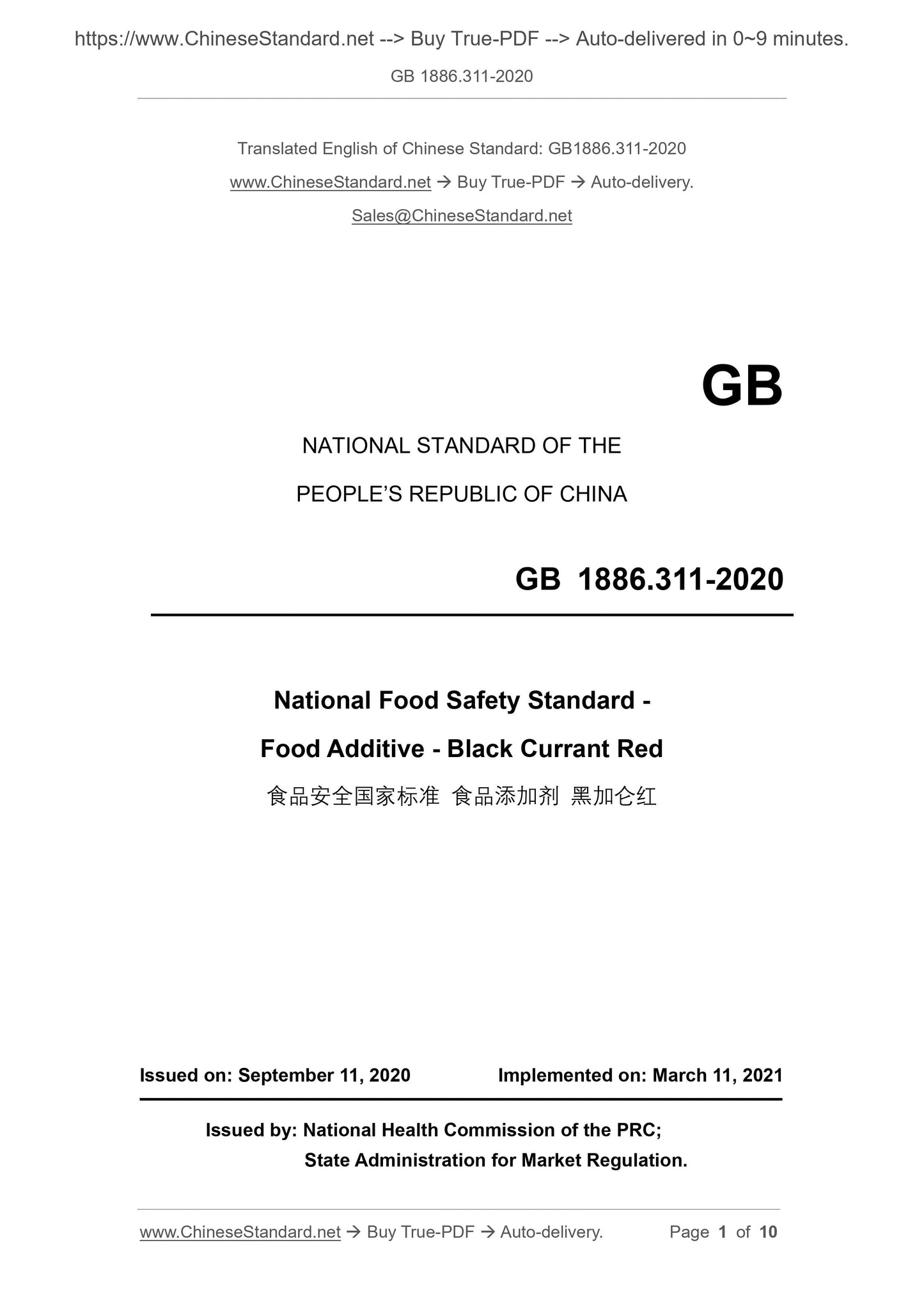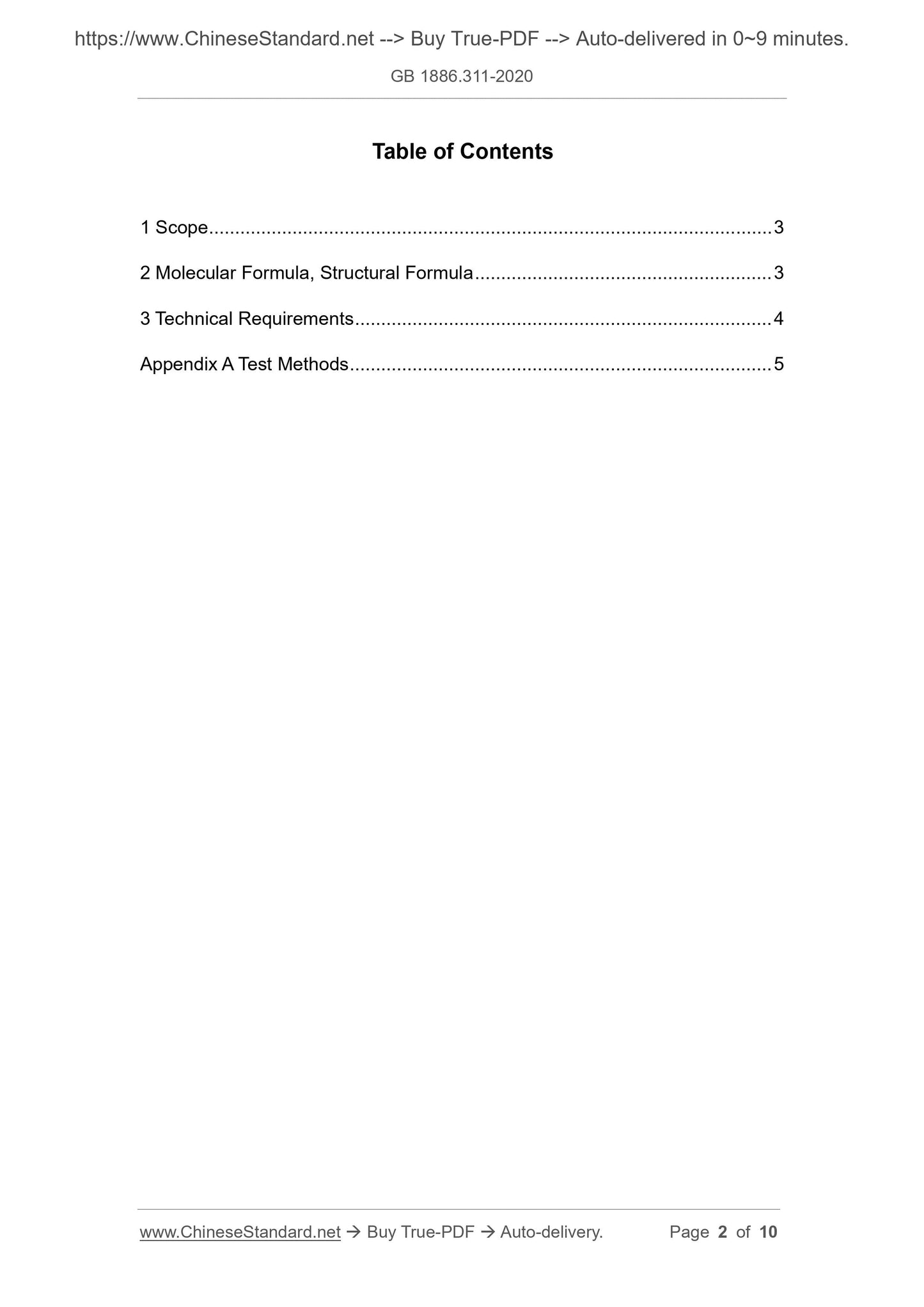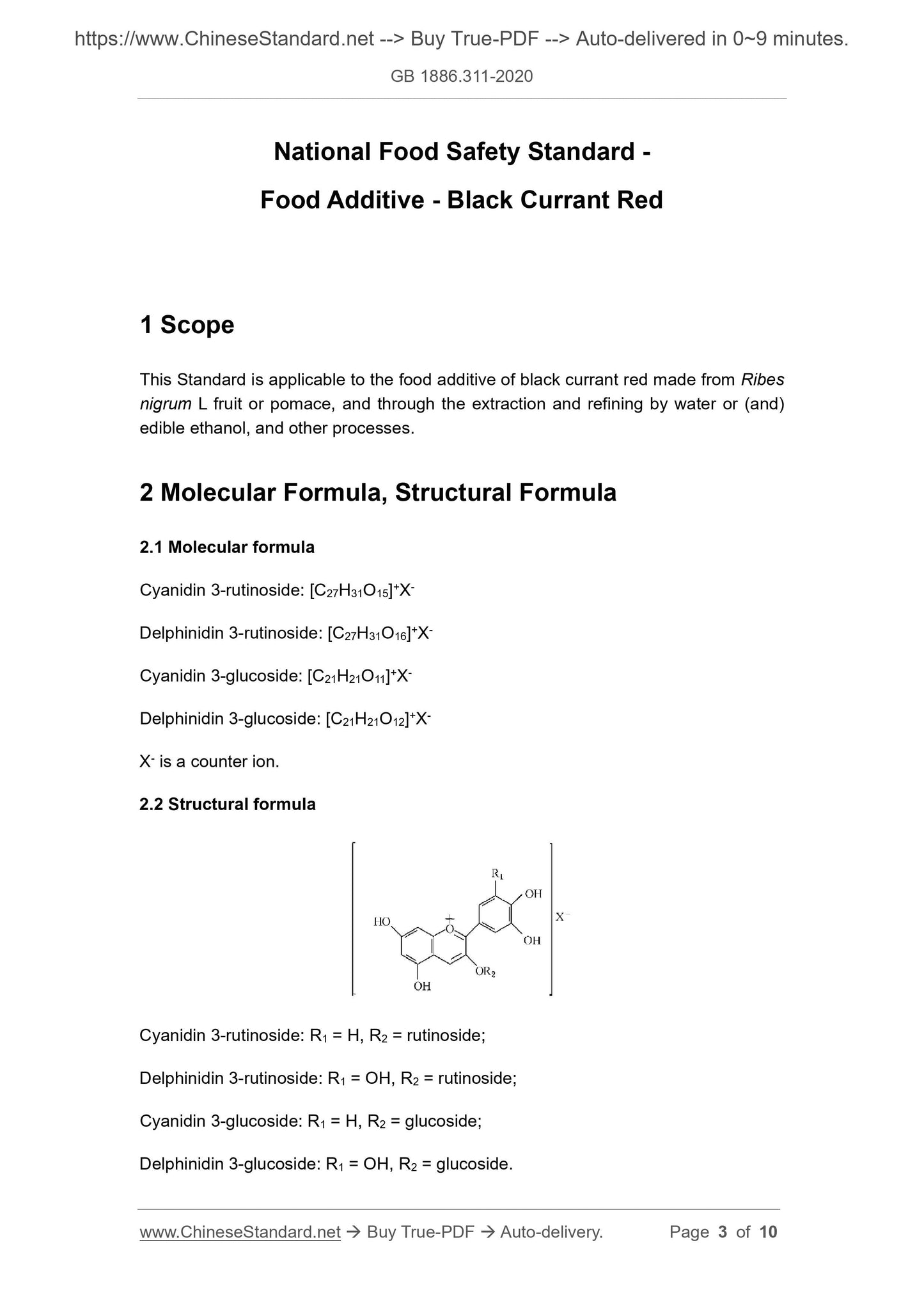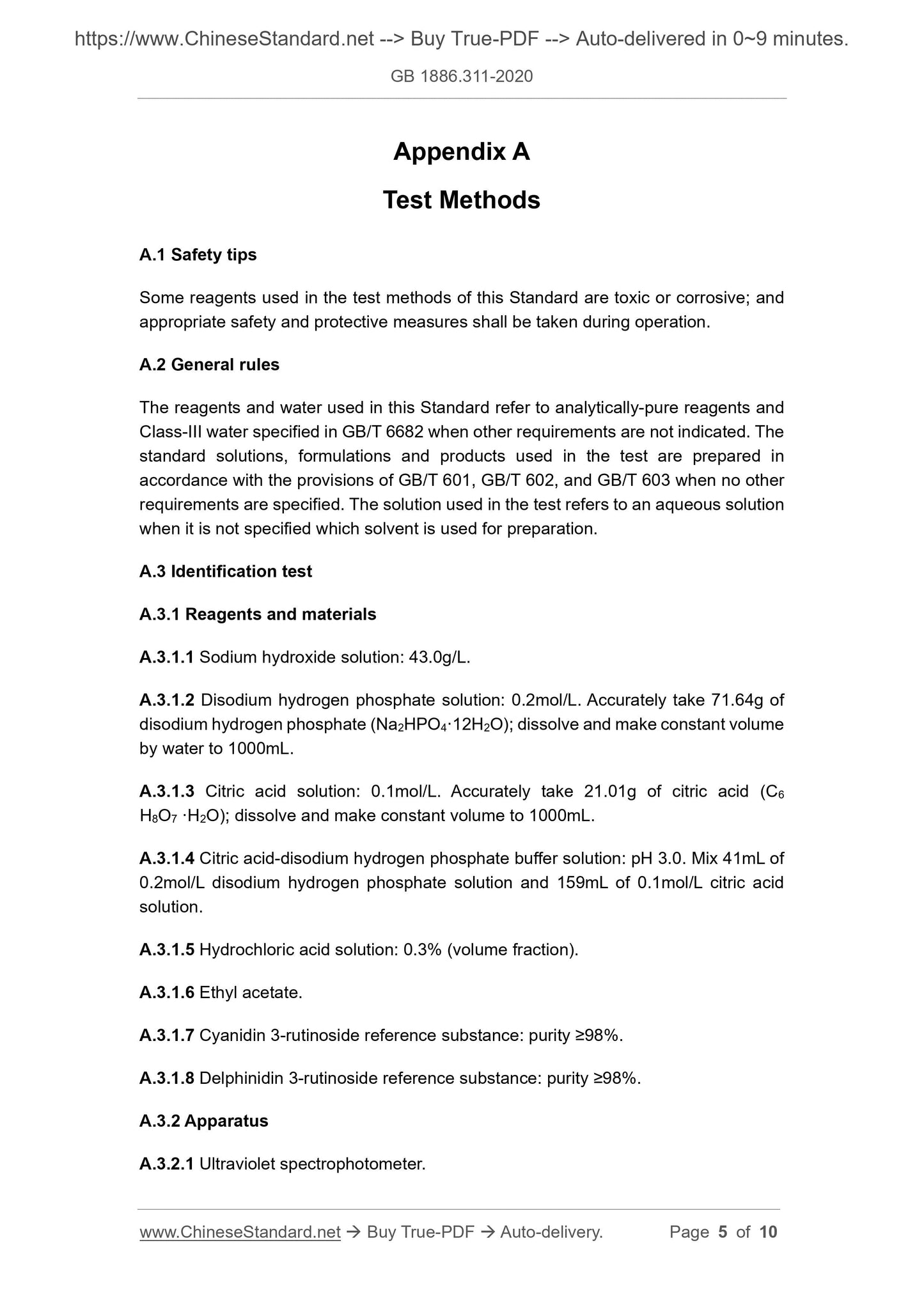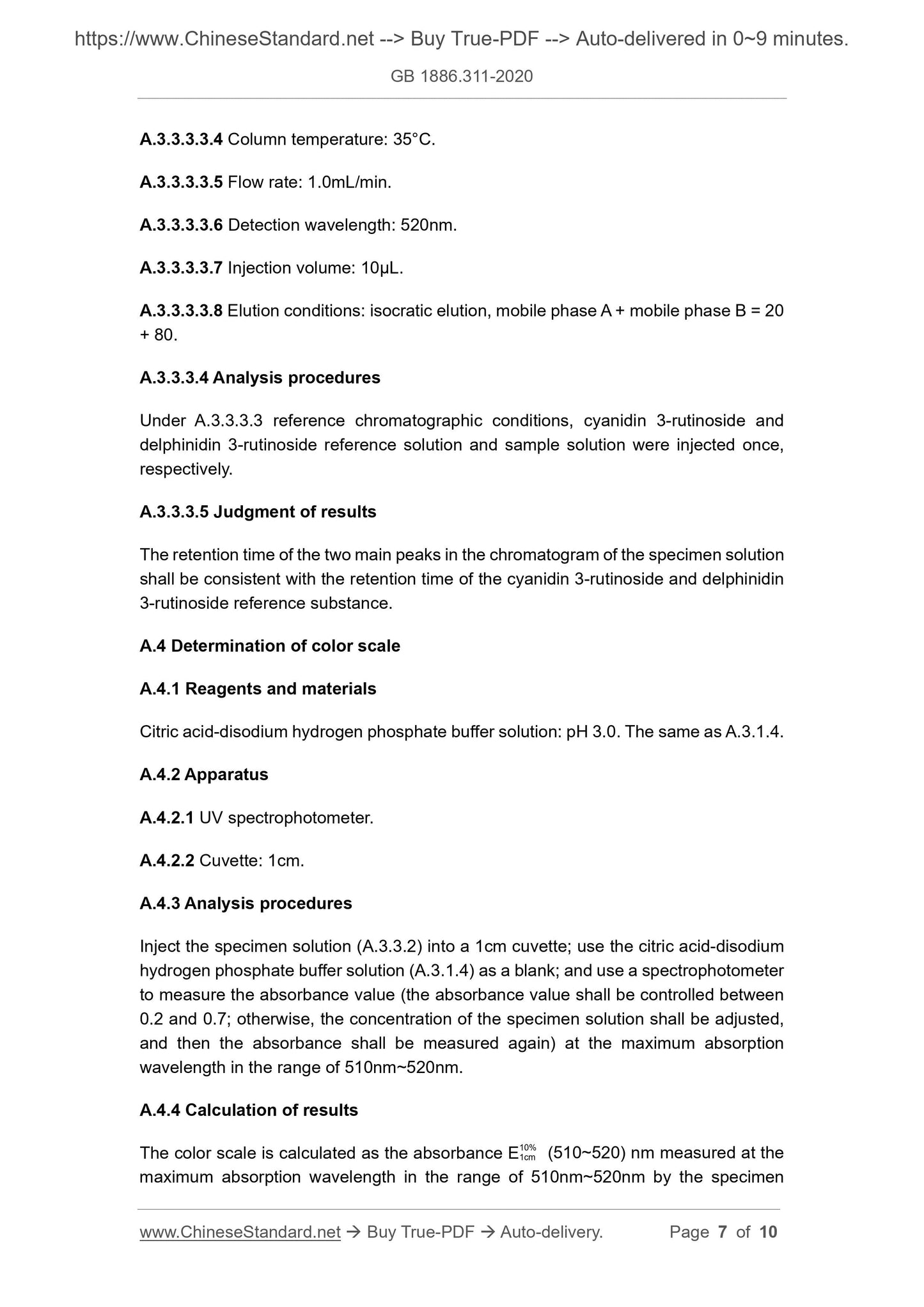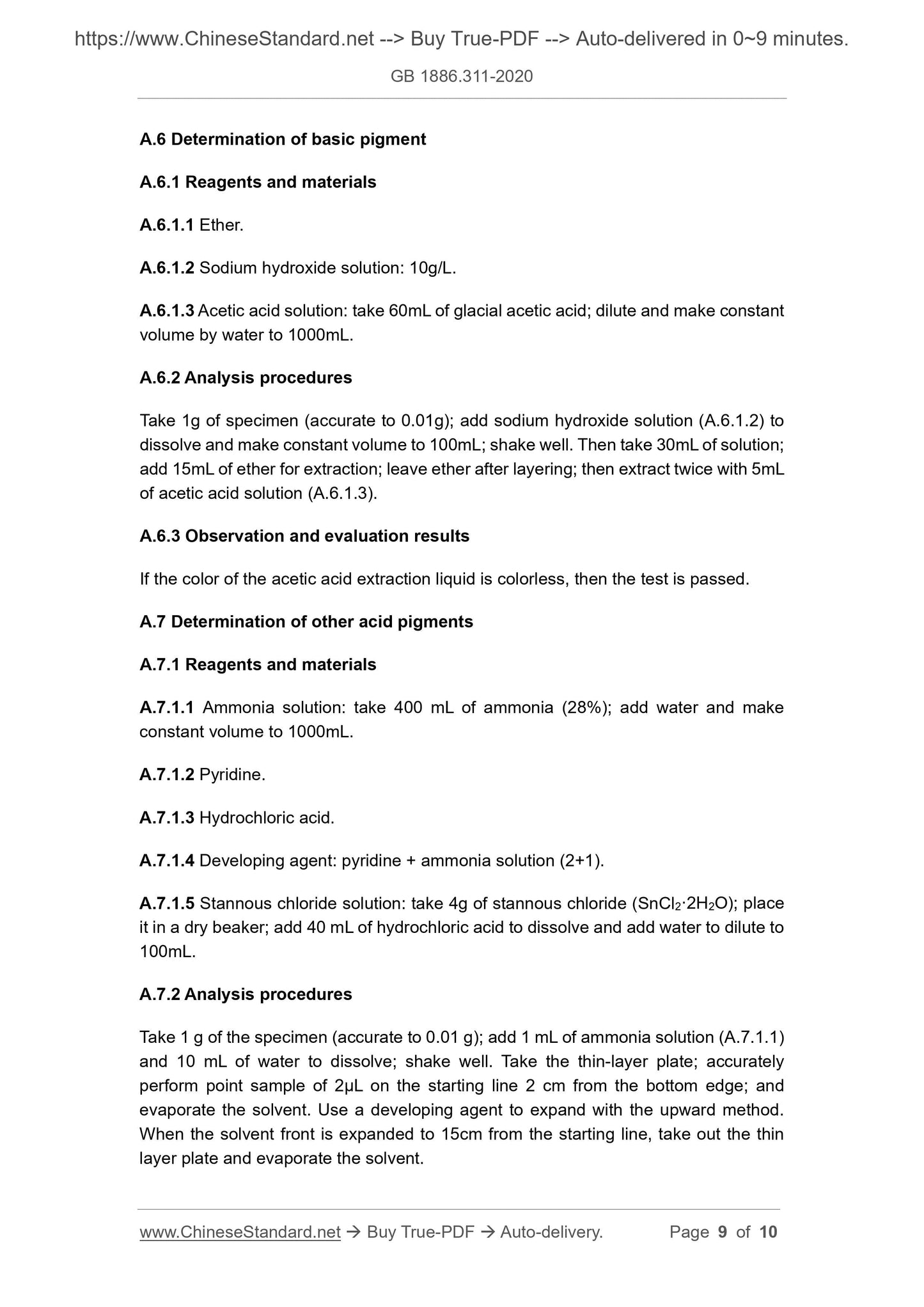1
/
of
6
PayPal, credit cards. Download editable-PDF & invoice In 1 second!
GB 1886.311-2020 English PDF
GB 1886.311-2020 English PDF
Regular price
$110.00 USD
Regular price
Sale price
$110.00 USD
Unit price
/
per
Shipping calculated at checkout.
Couldn't load pickup availability
Delivery: 3 seconds. Download true-PDF + Invoice.
Get QUOTATION in 1-minute: Click GB 1886.311-2020
Historical versions: GB 1886.311-2020
Preview True-PDF (Reload/Scroll if blank)
GB 1886.311-2020: National food safety standard - Food additive - Black currant red
GB 1886.311-2020
GB
NATIONAL STANDARD OF THE
PEOPLE’S REPUBLIC OF CHINA
National Food Safety Standard -
Food Additive - Black Currant Red
ISSUED ON: SEPTEMBER 11, 2020
IMPLEMENTED ON: MARCH 11, 2021
Issued by: National Health Commission of the PRC;
State Administration for Market Regulation.
Table of Contents
1 Scope ... 3
2 Molecular Formula, Structural Formula ... 3
3 Technical Requirements ... 4
Appendix A Test Methods ... 5
National Food Safety Standard -
Food Additive - Black Currant Red
1 Scope
This Standard is applicable to the food additive of black currant red made from Ribes
nigrum L fruit or pomace, and through the extraction and refining by water or (and)
edible ethanol, and other processes.
2 Molecular Formula, Structural Formula
2.1 Molecular formula
Cyanidin 3-rutinoside: [C27H31O15]+X-
Delphinidin 3-rutinoside: [C27H31O16]+X-
Cyanidin 3-glucoside: [C21H21O11]+X-
Delphinidin 3-glucoside: [C21H21O12]+X-
X- is a counter ion.
2.2 Structural formula
Cyanidin 3-rutinoside: R1 = H, R2 = rutinoside;
Delphinidin 3-rutinoside: R1 = OH, R2 = rutinoside;
Cyanidin 3-glucoside: R1 = H, R2 = glucoside;
Delphinidin 3-glucoside: R1 = OH, R2 = glucoside.
Appendix A
Test Methods
A.1 Safety tips
Some reagents used in the test methods of this Standard are toxic or corrosive; and
appropriate safety and protective measures shall be taken during operation.
A.2 General rules
The reagents and water used in this Standard refer to analytically-pure reagents and
Class-III water specified in GB/T 6682 when other requirements are not indicated. The
standard solutions, formulations and products used in the test are prepared in
accordance with the provisions of GB/T 601, GB/T 602, and GB/T 603 when no other
requirements are specified. The solution used in the test refers to an aqueous solution
when it is not specified which solvent is used for preparation.
A.3 Identification test
A.3.1 Reagents and materials
A.3.1.1 Sodium hydroxide solution: 43.0g/L.
A.3.1.2 Disodium hydrogen phosphate solution: 0.2mol/L. Accurately take 71.64g of
disodium hydrogen phosphate (Na2HPO4·12H2O); dissolve and make constant volume
by water to 1000mL.
A.3.1.3 Citric acid solution: 0.1mol/L. Accurately take 21.01g of citric acid (C6
H8O7 ·H2O); dissolve and make constant volume to 1000mL.
A.3.1.4 Citric acid-disodium hydrogen phosphate buffer solution: pH 3.0. Mix 41mL of
0.2mol/L disodium hydrogen phosphate solution and 159mL of 0.1mol/L citric acid
solution.
A.3.1.5 Hydrochloric acid solution: 0.3% (volume fraction).
A.3.1.6 Ethyl acetate.
A.3.1.7 Cyanidin 3-rutinoside reference substance: purity ≥98%.
A.3.1.8 Delphinidin 3-rutinoside reference substance: purity ≥98%.
A.3.2 Apparatus
A.3.2.1 Ultraviolet spectrophotometer.
A.3.3.3.3.4 Column temperature: 35°C.
A.3.3.3.3.5 Flow rate: 1.0mL/min.
A.3.3.3.3.6 Detection wavelength: 520nm.
A.3.3.3.3.7 Injection volume: 10μL.
A.3.3.3.3.8 Elution conditions: isocratic elution, mobile phase A + mobile phase B = 20
+ 80.
A.3.3.3.4 Analysis procedures
Under A.3.3.3.3 reference chromatographic conditions, cyanidin 3-rutinoside and
delphinidin 3-rutinoside reference solution and sample solution were injected once,
respectively.
A.3.3.3.5 Judgment of results
The retention time of the two main peaks in the chromatogram of the specimen solution
shall be consistent with the retention time of the cyanidin 3-rutinoside and delphinidin
3-rutinoside reference substance.
A.4 Determination of color scale
A.4.1 Reagents and materials
Citric acid-disodium hydrogen phosphate buffer solution: pH 3.0. The same as A.3.1.4.
A.4.2 Apparatus
A.4.2.1 UV spectrophotometer.
A.4.2.2 Cuvette: 1cm.
A.4.3 Analysis procedures
Inject the specimen solution (A.3.3.2) into a 1cm cuvette; use the citric acid-disodium
hydrogen phosphate buffer solution (A.3.1.4) as a blank; and use a spectrophotometer
to measure the absorbance value (the absorbance value shall be controlled between
0.2 and 0.7; otherwise, the concentration of the specimen solution shall be adjusted,
and then the absorbance shall be measured again) at the maximum absorption
wavelength in the range of 510nm~520nm.
A.4.4 Calculation of results
The color scale is calculated as the absorbance E10% 1cm (510~520) nm measured at the
maximum absorption wavelength in the range of 510nm~520nm by the specimen
A.6 Determination of basic pigment
A.6.1 Reagents and materials
A.6.1.1 Ether.
A.6.1.2 Sodium hydroxide solution: 10g/L.
A.6.1.3 Acetic acid solution: take 60mL of glacial acetic acid; dilute and make constant
volume by water to 1000mL.
A.6.2 Analysis procedures
Take 1g of specimen (accurate to 0.01g); add sodium hydroxide solution (A.6.1.2) to
dissolve and make constant volume to 100mL; shake well. Then take 30mL of solution;
add 15mL of ether for extraction; leave ether after layering; then extract twice with 5mL
of acetic acid solution (A.6.1.3).
A.6.3 Observation and evaluation results
If the color of the acetic acid extraction liquid is colorless, then the test is passed.
A.7 Determination of other acid pigments
A.7.1 Reagents and materials
A.7.1.1 Ammonia solution: take 400 mL of ammonia (28%); add water and make
constant volume to 1000mL.
A.7.1.2 Pyridine.
A.7.1.3 Hydrochloric acid.
A.7.1.4 Developing agent: pyridine + ammonia solution (2+1).
A.7.1.5 Stannous chloride solution: take 4g of stannous chloride (SnCl2·2H2O); place
it in a dry beaker; add 40 mL of hydrochloric acid to dissolve and add water to dilute to
100mL.
A.7.2 Analysis procedures
Take 1 g of the specimen (accurate to 0.01 g); add 1 mL of ammonia solution (A.7.1.1)
and 10 mL of water to dissolve; shake well. Take the thin-layer plate; accurately
perform point sample of 2μL on the starting line 2 cm from the bottom edge; and
evaporate the solvent. Use a developing agent to expand with the upward method.
When the solvent front is expanded to 15cm from the starting line, take out the thin
layer plate and evaporate the solvent.
Get QUOTATION in 1-minute: Click GB 1886.311-2020
Historical versions: GB 1886.311-2020
Preview True-PDF (Reload/Scroll if blank)
GB 1886.311-2020: National food safety standard - Food additive - Black currant red
GB 1886.311-2020
GB
NATIONAL STANDARD OF THE
PEOPLE’S REPUBLIC OF CHINA
National Food Safety Standard -
Food Additive - Black Currant Red
ISSUED ON: SEPTEMBER 11, 2020
IMPLEMENTED ON: MARCH 11, 2021
Issued by: National Health Commission of the PRC;
State Administration for Market Regulation.
Table of Contents
1 Scope ... 3
2 Molecular Formula, Structural Formula ... 3
3 Technical Requirements ... 4
Appendix A Test Methods ... 5
National Food Safety Standard -
Food Additive - Black Currant Red
1 Scope
This Standard is applicable to the food additive of black currant red made from Ribes
nigrum L fruit or pomace, and through the extraction and refining by water or (and)
edible ethanol, and other processes.
2 Molecular Formula, Structural Formula
2.1 Molecular formula
Cyanidin 3-rutinoside: [C27H31O15]+X-
Delphinidin 3-rutinoside: [C27H31O16]+X-
Cyanidin 3-glucoside: [C21H21O11]+X-
Delphinidin 3-glucoside: [C21H21O12]+X-
X- is a counter ion.
2.2 Structural formula
Cyanidin 3-rutinoside: R1 = H, R2 = rutinoside;
Delphinidin 3-rutinoside: R1 = OH, R2 = rutinoside;
Cyanidin 3-glucoside: R1 = H, R2 = glucoside;
Delphinidin 3-glucoside: R1 = OH, R2 = glucoside.
Appendix A
Test Methods
A.1 Safety tips
Some reagents used in the test methods of this Standard are toxic or corrosive; and
appropriate safety and protective measures shall be taken during operation.
A.2 General rules
The reagents and water used in this Standard refer to analytically-pure reagents and
Class-III water specified in GB/T 6682 when other requirements are not indicated. The
standard solutions, formulations and products used in the test are prepared in
accordance with the provisions of GB/T 601, GB/T 602, and GB/T 603 when no other
requirements are specified. The solution used in the test refers to an aqueous solution
when it is not specified which solvent is used for preparation.
A.3 Identification test
A.3.1 Reagents and materials
A.3.1.1 Sodium hydroxide solution: 43.0g/L.
A.3.1.2 Disodium hydrogen phosphate solution: 0.2mol/L. Accurately take 71.64g of
disodium hydrogen phosphate (Na2HPO4·12H2O); dissolve and make constant volume
by water to 1000mL.
A.3.1.3 Citric acid solution: 0.1mol/L. Accurately take 21.01g of citric acid (C6
H8O7 ·H2O); dissolve and make constant volume to 1000mL.
A.3.1.4 Citric acid-disodium hydrogen phosphate buffer solution: pH 3.0. Mix 41mL of
0.2mol/L disodium hydrogen phosphate solution and 159mL of 0.1mol/L citric acid
solution.
A.3.1.5 Hydrochloric acid solution: 0.3% (volume fraction).
A.3.1.6 Ethyl acetate.
A.3.1.7 Cyanidin 3-rutinoside reference substance: purity ≥98%.
A.3.1.8 Delphinidin 3-rutinoside reference substance: purity ≥98%.
A.3.2 Apparatus
A.3.2.1 Ultraviolet spectrophotometer.
A.3.3.3.3.4 Column temperature: 35°C.
A.3.3.3.3.5 Flow rate: 1.0mL/min.
A.3.3.3.3.6 Detection wavelength: 520nm.
A.3.3.3.3.7 Injection volume: 10μL.
A.3.3.3.3.8 Elution conditions: isocratic elution, mobile phase A + mobile phase B = 20
+ 80.
A.3.3.3.4 Analysis procedures
Under A.3.3.3.3 reference chromatographic conditions, cyanidin 3-rutinoside and
delphinidin 3-rutinoside reference solution and sample solution were injected once,
respectively.
A.3.3.3.5 Judgment of results
The retention time of the two main peaks in the chromatogram of the specimen solution
shall be consistent with the retention time of the cyanidin 3-rutinoside and delphinidin
3-rutinoside reference substance.
A.4 Determination of color scale
A.4.1 Reagents and materials
Citric acid-disodium hydrogen phosphate buffer solution: pH 3.0. The same as A.3.1.4.
A.4.2 Apparatus
A.4.2.1 UV spectrophotometer.
A.4.2.2 Cuvette: 1cm.
A.4.3 Analysis procedures
Inject the specimen solution (A.3.3.2) into a 1cm cuvette; use the citric acid-disodium
hydrogen phosphate buffer solution (A.3.1.4) as a blank; and use a spectrophotometer
to measure the absorbance value (the absorbance value shall be controlled between
0.2 and 0.7; otherwise, the concentration of the specimen solution shall be adjusted,
and then the absorbance shall be measured again) at the maximum absorption
wavelength in the range of 510nm~520nm.
A.4.4 Calculation of results
The color scale is calculated as the absorbance E10% 1cm (510~520) nm measured at the
maximum absorption wavelength in the range of 510nm~520nm by the specimen
A.6 Determination of basic pigment
A.6.1 Reagents and materials
A.6.1.1 Ether.
A.6.1.2 Sodium hydroxide solution: 10g/L.
A.6.1.3 Acetic acid solution: take 60mL of glacial acetic acid; dilute and make constant
volume by water to 1000mL.
A.6.2 Analysis procedures
Take 1g of specimen (accurate to 0.01g); add sodium hydroxide solution (A.6.1.2) to
dissolve and make constant volume to 100mL; shake well. Then take 30mL of solution;
add 15mL of ether for extraction; leave ether after layering; then extract twice with 5mL
of acetic acid solution (A.6.1.3).
A.6.3 Observation and evaluation results
If the color of the acetic acid extraction liquid is colorless, then the test is passed.
A.7 Determination of other acid pigments
A.7.1 Reagents and materials
A.7.1.1 Ammonia solution: take 400 mL of ammonia (28%); add water and make
constant volume to 1000mL.
A.7.1.2 Pyridine.
A.7.1.3 Hydrochloric acid.
A.7.1.4 Developing agent: pyridine + ammonia solution (2+1).
A.7.1.5 Stannous chloride solution: take 4g of stannous chloride (SnCl2·2H2O); place
it in a dry beaker; add 40 mL of hydrochloric acid to dissolve and add water to dilute to
100mL.
A.7.2 Analysis procedures
Take 1 g of the specimen (accurate to 0.01 g); add 1 mL of ammonia solution (A.7.1.1)
and 10 mL of water to dissolve; shake well. Take the thin-layer plate; accurately
perform point sample of 2μL on the starting line 2 cm from the bottom edge; and
evaporate the solvent. Use a developing agent to expand with the upward method.
When the solvent front is expanded to 15cm from the starting line, take out the thin
layer plate and evaporate the solvent.
Share
